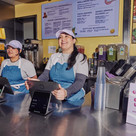Table of contents
This article was contributed by Matthew Tilley from Ad Age.
Editor’s note: It’s important to ensure your marketing efforts resonate with consumers in an authentic way. The research and takeaways below can help inform your marketing strategy as the pandemic continues. Learn more about finding the right tone for your business in our voice and tone guide, along with our curated list of COVID-19 resources that can help you manage this next stage.
We live in uncertain times. But there are powerful indicators, signaled by a new report from Valassis, of a shift to a cautious optimism about life in general, and a re-evaluation of the brands people relate to and trust.
1. Getting your messaging right
People have a pent-up desire to move forward after a rocky year, so there’s a big opportunity for messaging that conveys forward momentum and, it is hoped, situates the worst of the pandemic in the rearview mirror.
It’s essential for marketers to listen to near real-time data, and then pivot to how they engage with people based on what they hear. Consider: 68% of study respondents overall prefer messages that are uplifting, and 73% of Gen X and parents feel this way as well. About the same percentage of people prefer humorous ads.
Critically, messages that recognize the pandemic but offer hope and optimism are popular. Also in the uplifting vein, there appears to be a closer affinity with shopping at local neighborhood stores. 61% of consumers plan their in-store shopping with recommendations from family and friends, and 70% are interested in ads supporting local businesses — both up substantially after the first onset of the pandemic. Call this a heightened human-focused connection to community, so be aware of it.
Takeaway: Brands need to win over entire families in local areas, which means neighborhood and household-level targeting for campaigns. Call it affinity messaging — we are all among our community and support our friends, families and neighborhoods.
2. Acknowledge a commitment to safety
Personal health and safety will be a real concern for the foreseeable future and needs to be a serious consideration for all indoor activities. Messaging and promotions for indoor activities should address health concerns and highlight precautions taken by an establishment, so advertising that promotes a safer community will pay dividends.
Restaurants in particular have to adapt since there’s still a strong inclination (63%) for people to order carryout or delivery. But it pays to watch people categories: Parents (61%), millennial parents (60%) and Gen Z (48%) represent the highest number of consumers comfortable with restaurant dining, but clearly there is still an overall degree of caution about returning to restaurants. Local advertising targeting millennials and family promotions seem to be the strongest approach.
Takeaway: Overall, health and welfare are in the zeitgeist. 64% of millennials, 70% of parents and 72% of millennial parents are interested in ads that focus on health and wellness.
3. Demonstrate a social conscience
After the height of the pandemic, and with a reassessment of the meaning of life, our survey respondents are driving to a greater social empathy. As many as 52% of respondents say it’s important that the brands they purchase from have values aligning with their own. And what are those values? Among millennial parents, 72% are more likely to be loyal to a brand or store that shares their efforts to be environmentally responsible, or has sustainable or ethical business practices.
Takeaway: While people want to shop local and reward the stores and restaurants that have suffered, it’s also clear they want to buy from brands that demonstrate fair practices, evince environmental consideration and have a social conscience.
4. Build rewarding in-store experiences
While people are still unsure about indoor activities, shopping is a notable exception, and people are keen to return. Retailers should consider new opportunities for experiential elements, such as having assistants on hand to direct shoppers in a safe way, or offering touch-free interactions supported by QR codes, AR experiences and “endless aisle” capabilities where nothing is out of stock.
But that’s not all of it. People are more conscious of discounts after the pandemic, illustrative of the “cautious” part of optimism. More than four out of five study respondents say the most important thing when shopping for groceries is cost, and shop at stores with lower prices. More than half say a sale will drive an impulse purchase.
Importantly, while online shopping boomed last year, it may have peaked. In our study, shopping indoors performed better (at 49%) than most other indoor activities in terms of comfort level, and fully 74% of people prefer to buy products that they can smell, touch or feel. Consider: Online food shopping has actually declined in 2021, compared with 2020—18% of respondents versus 29% in 2020.
Takeaway: Driving shoppers online to find more coupons — thereby pulling them into the brand ecosystem — helps them plan how to shop in advance. Physical mail inspires action, addresses caution and augments the in-store experience.
Findings from “The Cautious Return to a New World” are based on the responses of an online consumer panel of 1,004 U.S. adults. The study was fielded over two weeks in February and March 2021
This article was written by Matthew Tilley from Ad Age and was legally licensed through the Industry Dive publisher network. Please direct all licensing questions to [email protected].
![]()











